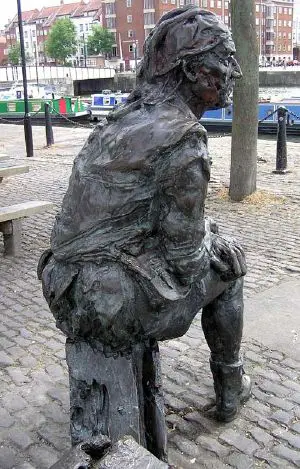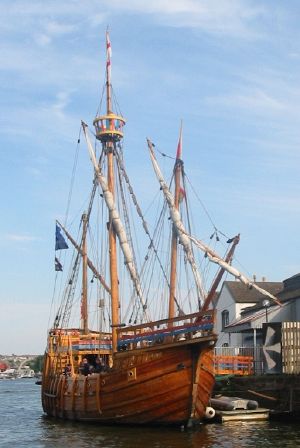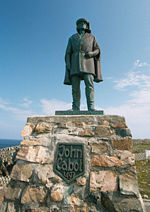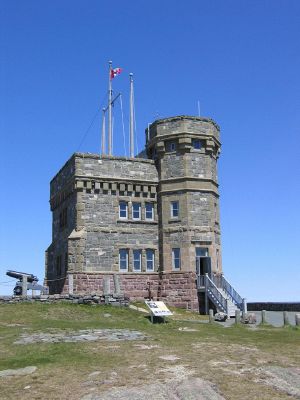Difference between revisions of "John Cabot" - New World Encyclopedia
(import, credit, category) |
(dates) |
||
| Line 3: | Line 3: | ||
[[image:bristol.john.cabot.500pix.jpg|thumb|John Cabot gazing across Bristol Harbour.]] | [[image:bristol.john.cabot.500pix.jpg|thumb|John Cabot gazing across Bristol Harbour.]] | ||
[[Image:Matthew-BristolHarbour-Aug2004.jpg|thumb|A replica of the ''Matthew'' in Bristol [[Bristol Harbour|Floating Harbour]], August 2004.]] | [[Image:Matthew-BristolHarbour-Aug2004.jpg|thumb|A replica of the ''Matthew'' in Bristol [[Bristol Harbour|Floating Harbour]], August 2004.]] | ||
| − | '''Giovanni Caboto''' ([[circa|c.]] | + | '''Giovanni Caboto''' ([[circa|c.]] 1450 – c.1499), known in [[English language|English]] as '''John Cabot''', was an [[Italy|Italian]] [[navigator]] and [[exploration|explorer]] commonly credited as the first [[early modern Europe]]an to discover the [[North America]]n mainland, in 1497. |
==Biography== | ==Biography== | ||
| Line 14: | Line 14: | ||
King [[Henry VII of England]] gave him a grant to go on ''"full and free authoritie, leave, and power, to sayle to all partes, countreys, a see as, of the East, of the West, and of the North, under our banners and ensignes, with five ships ... and as many mariners or men as they will have in saide ships, upon their own proper costes and charges, to seeke out, discover, and finde, whatsoever iles, countreyes, regions or provinces of the heathen and infidelles, whatsoever they bee, and in what part of the world soever they be, whiche before this time have beene unknowen to all Christians."'' | King [[Henry VII of England]] gave him a grant to go on ''"full and free authoritie, leave, and power, to sayle to all partes, countreys, a see as, of the East, of the West, and of the North, under our banners and ensignes, with five ships ... and as many mariners or men as they will have in saide ships, upon their own proper costes and charges, to seeke out, discover, and finde, whatsoever iles, countreyes, regions or provinces of the heathen and infidelles, whatsoever they bee, and in what part of the world soever they be, whiche before this time have beene unknowen to all Christians."'' | ||
| − | Cabot went to Bristol to make the preparations for his voyage. [[Bristol]] was the second-largest seaport in England, and during the years from | + | Cabot went to Bristol to make the preparations for his voyage. [[Bristol]] was the second-largest seaport in England, and during the years from 1480 onwards several expeditions had been sent out to look for [[Hy-Brazil]], an island that would lie somewhere in the [[Atlantic Ocean]] according to [[Celts|Celtic]] legends. Some people think [[Newfoundland]] may have been found on one of these voyages. |
[[Image:Johncabotbonavista.jpg|left|thumb|150px|John Cabot in Bonavista, Newfoundland.]] | [[Image:Johncabotbonavista.jpg|left|thumb|150px|John Cabot in Bonavista, Newfoundland.]] | ||
| − | In | + | In 1496 Cabot started out from Bristol with one ship. But he got no further than [[Iceland]] and was forced to return because of disputes with the crew. |
| − | On a second voyage Cabot again used only one ship with 18 crew, the ''[[Matthew (ship)|Matthew]]'', a small ship (50 tons), but fast and able. He departed either May 2 or May 20, | + | On a second voyage Cabot again used only one ship with 18 crew, the ''[[Matthew (ship)|Matthew]]'', a small ship (50 tons), but fast and able. He departed either May 2 or May 20, 1497 and sailed to [[Dursey Head]], [[Ireland]], from where he sailed due west to Asia - or so he thought. He landed on the coast of Newfoundland on June 24, 1497. His precise landing-place is a matter of much controversy, either [[Bonavista, Newfoundland|Bonavista]] or [[St. John's, Newfoundland|St. John's]]. He went ashore to take possession of the land, and explored the coast for some time, probably departing on July 20. On the homeward voyage his sailors thought they were going too far north, so Cabot sailed a more southerly course, reaching [[Brittany]] instead of England and on August 6 arrived back in Bristol. |
[[Image:Cabottowernf.jpg|thumb|[[Cabot Tower (Newfoundland)|Cabot Tower]] in St. John's Newfoundland.]] | [[Image:Cabottowernf.jpg|thumb|[[Cabot Tower (Newfoundland)|Cabot Tower]] in St. John's Newfoundland.]] | ||
| − | The location of Cabot's first landfall is still unknown, because of lack of evidence. Many experts think it was on Cape Bonavista, Newfoundland, but others look for it in [[Cape Breton Island]], [[Nova Scotia]], [[Labrador]], or [[Maine]]. Cape Bonavista, however, is the location recognised by the governments of [[Canada]] and the [[United Kingdom]] as being Cabot's official landing. His men may have been the first Europeans on either American continent since the Vikings: [[Christopher Columbus]] did not find the mainland until his third voyage, in | + | The location of Cabot's first landfall is still unknown, because of lack of evidence. Many experts think it was on Cape Bonavista, Newfoundland, but others look for it in [[Cape Breton Island]], [[Nova Scotia]], [[Labrador]], or [[Maine]]. Cape Bonavista, however, is the location recognised by the governments of [[Canada]] and the [[United Kingdom]] as being Cabot's official landing. His men may have been the first Europeans on either American continent since the Vikings: [[Christopher Columbus]] did not find the mainland until his third voyage, in 1498, and letters referring to a voyage by [[Amerigo Vespucci]] in 1497 are generally believed to have been forgeries or fabrications. |
Back in England, Cabot was made an admiral, rewarded with £10 and a patent was written for a new voyage. Later, a pension of £20 a year was granted him. The next year, [[1498]], he departed again, with 5 ships this time. The expedition made for an Irish port, because of distress. Except for one ship, John Cabot and his expedition were never heard from again. | Back in England, Cabot was made an admiral, rewarded with £10 and a patent was written for a new voyage. Later, a pension of £20 a year was granted him. The next year, [[1498]], he departed again, with 5 ships this time. The expedition made for an Irish port, because of distress. Except for one ship, John Cabot and his expedition were never heard from again. | ||
| − | John's son [[Sebastian Cabot (explorer)|Sebastian Cabot]] later made a voyage to North America, looking for the [[Northwest Passage]] ( | + | John's son [[Sebastian Cabot (explorer)|Sebastian Cabot]] later made a voyage to North America, looking for the [[Northwest Passage]] (1508), and one to repeat [[Ferdinand Magellan|Magellan]]'s voyage around the world, which ended up looking for [[silver]] along the [[Río de la Plata]] (1525-8). |
| − | In | + | In 1498-1500 a few [[Portugal|Portuguese]] travelers, [[Miguel Corte-Real|Miguel]] and [[Gaspar Corte-Real]] being the most famous participants, visited [[Greenland]], Labrador and Newfoundland. In 1501-1505 an English syndicate, consisting of 3 [[Azores|Azoreans]] and 2 English traders, made voyages to Newfoundland. From 1504, if not before, Breton, [[Basque people|Basque]], Portuguese and English fishermen crossed the ocean to catch fish on the [[Grand Banks|Newfoundland banks]]. |
| − | Cabot is remembered in Bristol by the [[Cabot Tower (Bristol)|Cabot Tower]], a 30-metre tall red sandstone tower of | + | Cabot is remembered in Bristol by the [[Cabot Tower (Bristol)|Cabot Tower]], a 30-metre tall red sandstone tower of 1897 (the 400th anniversary of the landing) on Brandon Hill near the city center, by a replica of the ''Matthew'' built in the city and by a statue of the explorer on the harbourside. |
== Gallery == | == Gallery == | ||
| Line 38: | Line 38: | ||
Image:Cabot tower stamp.jpg|Cabot Tower (Newfoundland) postage stamp | Image:Cabot tower stamp.jpg|Cabot Tower (Newfoundland) postage stamp | ||
Image:Cabotstamp.jpg|John Cabot Stamp. | Image:Cabotstamp.jpg|John Cabot Stamp. | ||
| − | Image:nlc000840-v6.jpg|Letters patent for a voyage to discover new lands granted to John Cabot and his three sons by the king of [[England]], [[Henry VII of England|Henry VII]], at Westminster on | + | Image:nlc000840-v6.jpg|Letters patent for a voyage to discover new lands granted to John Cabot and his three sons by the king of [[England]], [[Henry VII of England|Henry VII]], at Westminster on March 5, 1496. |
</gallery> | </gallery> | ||
Revision as of 23:16, 14 July 2006
Giovanni Caboto (c. 1450 – c.1499), known in English as John Cabot, was an Italian navigator and explorer commonly credited as the first early modern European to discover the North American mainland, in 1497.
Biography
Cabot was born in 1451 (the exact date and place of birth are uncertain) in Genoa, Gaeta, or Chioggia (this is also uncertain). In his youth he moved to Venice and became a Venetian citizen.
Like other Italian explorers of the era, such as Christopher Columbus (Cristoforo Colombo), Cabot made another country his base of operations. For Cabot it was England, so his explorations were made under the English flag. The voyage that saw him and his crew discover the North American mainland – the first Europeans known to do so since the Vikings – took place in 1497, five years after Columbus' discovery of the Caribbean. Again, like Columbus, Cabot's intention had been to find a westerly sea route to Asia.
It was probably on hearing of Columbus's discovery of 'the Indies' that he decided to find a route to the west for himself. He went with his plans to England, because he incorrectly thought spices were coming from northern Asia; and a degree of longitude is shorter the further one is from the equator, so the voyage from western Europe to eastern Asia would be shorter at higher latitudes.
King Henry VII of England gave him a grant to go on "full and free authoritie, leave, and power, to sayle to all partes, countreys, a see as, of the East, of the West, and of the North, under our banners and ensignes, with five ships ... and as many mariners or men as they will have in saide ships, upon their own proper costes and charges, to seeke out, discover, and finde, whatsoever iles, countreyes, regions or provinces of the heathen and infidelles, whatsoever they bee, and in what part of the world soever they be, whiche before this time have beene unknowen to all Christians."
Cabot went to Bristol to make the preparations for his voyage. Bristol was the second-largest seaport in England, and during the years from 1480 onwards several expeditions had been sent out to look for Hy-Brazil, an island that would lie somewhere in the Atlantic Ocean according to Celtic legends. Some people think Newfoundland may have been found on one of these voyages.
In 1496 Cabot started out from Bristol with one ship. But he got no further than Iceland and was forced to return because of disputes with the crew. On a second voyage Cabot again used only one ship with 18 crew, the Matthew, a small ship (50 tons), but fast and able. He departed either May 2 or May 20, 1497 and sailed to Dursey Head, Ireland, from where he sailed due west to Asia - or so he thought. He landed on the coast of Newfoundland on June 24, 1497. His precise landing-place is a matter of much controversy, either Bonavista or St. John's. He went ashore to take possession of the land, and explored the coast for some time, probably departing on July 20. On the homeward voyage his sailors thought they were going too far north, so Cabot sailed a more southerly course, reaching Brittany instead of England and on August 6 arrived back in Bristol.
The location of Cabot's first landfall is still unknown, because of lack of evidence. Many experts think it was on Cape Bonavista, Newfoundland, but others look for it in Cape Breton Island, Nova Scotia, Labrador, or Maine. Cape Bonavista, however, is the location recognised by the governments of Canada and the United Kingdom as being Cabot's official landing. His men may have been the first Europeans on either American continent since the Vikings: Christopher Columbus did not find the mainland until his third voyage, in 1498, and letters referring to a voyage by Amerigo Vespucci in 1497 are generally believed to have been forgeries or fabrications.
Back in England, Cabot was made an admiral, rewarded with £10 and a patent was written for a new voyage. Later, a pension of £20 a year was granted him. The next year, 1498, he departed again, with 5 ships this time. The expedition made for an Irish port, because of distress. Except for one ship, John Cabot and his expedition were never heard from again.
John's son Sebastian Cabot later made a voyage to North America, looking for the Northwest Passage (1508), and one to repeat Magellan's voyage around the world, which ended up looking for silver along the Río de la Plata (1525-8).
In 1498-1500 a few Portuguese travelers, Miguel and Gaspar Corte-Real being the most famous participants, visited Greenland, Labrador and Newfoundland. In 1501-1505 an English syndicate, consisting of 3 Azoreans and 2 English traders, made voyages to Newfoundland. From 1504, if not before, Breton, Basque, Portuguese and English fishermen crossed the ocean to catch fish on the Newfoundland banks.
Cabot is remembered in Bristol by the Cabot Tower, a 30-metre tall red sandstone tower of 1897 (the 400th anniversary of the landing) on Brandon Hill near the city center, by a replica of the Matthew built in the city and by a statue of the explorer on the harbourside.
Gallery
- Cabot.tower.bristol.1.arp.jpg
Cabot Tower (Bristol), distant view
- Cabot.tower.bristol.3.arp.jpg
Cabot Tower (Bristol), close up
- Cabot.tower.bristol.4.arp.jpg
Cabot Tower (Bristol), extreme close up. Notice the CCCC on the turret (meaning 400)
- Cabot Tower plaque.jpg
Plaque inside Cabot Tower (Newfoundland)
- Cabot tower stamp.jpg
Cabot Tower (Newfoundland) postage stamp
- Cabotstamp.jpg
John Cabot Stamp.
- Nlc000840-v6.jpg
Letters patent for a voyage to discover new lands granted to John Cabot and his three sons by the king of England, Henry VII, at Westminster on March 5, 1496.
External links and references
- Biography at the Dictionary of Canadian Biography Online
- This article incorporates material from http://www.win.tue.nl/~engels/discovery/cabot.html . Copied with permission.
- Catholic Encyclopedia "John & Sebastian Cabot"
- Gibbons, Henry K. 1997. The Myth and Mystery of John Cabot: The Discoverer of North America. Marten Cat Publishers, Port Aux Basques, Newfoundland.
- Derek Croxton, The Cabot Dilemma: John Cabot's 1497 Voyage & the Limits of Historiography, 1990-1991
- The John Day Letter 1497-1498
- Home page of the Matthew replica with information about Cabot and the voyage.
- John Cabot memorial Cape Breton Island, Nova Scotia
Further reading
- Gibbons, Henry K. 1997. The Myth and Mystery of John Cabot: The Discoverer of North America. Marten Cat Publishers, Port Aux Basques, Newfoundland.
Credits
New World Encyclopedia writers and editors rewrote and completed the Wikipedia article in accordance with New World Encyclopedia standards. This article abides by terms of the Creative Commons CC-by-sa 3.0 License (CC-by-sa), which may be used and disseminated with proper attribution. Credit is due under the terms of this license that can reference both the New World Encyclopedia contributors and the selfless volunteer contributors of the Wikimedia Foundation. To cite this article click here for a list of acceptable citing formats.The history of earlier contributions by wikipedians is accessible to researchers here:
The history of this article since it was imported to New World Encyclopedia:
Note: Some restrictions may apply to use of individual images which are separately licensed.



